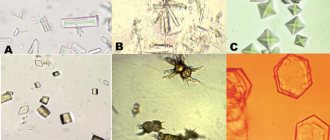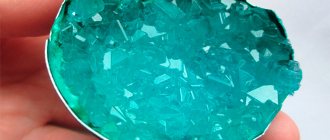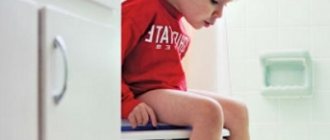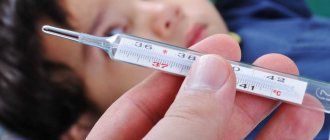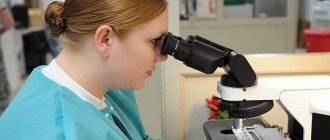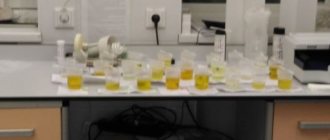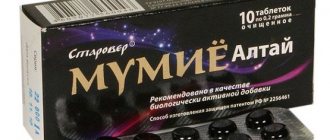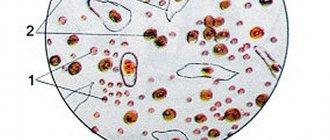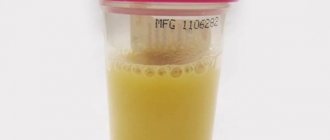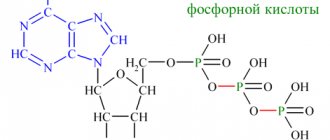In the modern world, we are increasingly hearing about the problem of acetone appearing in a child’s urine. Nutrition, ecology, stressful situations - all these are provocateurs for the development of acetone syndrome in children of different ages. It is extremely important not to miss the first symptoms of this phenomenon. The health of the child will depend on this.
Reasons for the accumulation of harmful substances in the body
Excessive accumulation of partial oxidation products occurs under the influence of many factors. Ketonuria is especially dangerous for pregnant women and patients with severe forms of chronic pathologies. Acetonuria is a sign of metabolic disorders; the condition may worsen due to endocrine pathologies, for example, diabetes mellitus.
The main reasons for the increase in acetone in urine:
- prolonged fasting;
- frequent use of diets that limit the intake of carbohydrates;
- poor diet, addiction to fried, fatty foods;
- excess protein in the diet, which is difficult to break down;
- pancreatic depletion in type 2 diabetes mellitus;
- cerebral coma;
- diabetes mellitus (first type of pathology);
- a sharp increase in insulin levels;
- severe infectious diseases;
- high physical activity, excessive training in the gym;
- intoxication after excessive consumption of alcohol or intake of low-quality alcoholic beverages;
- poisoning with chemicals and salts of heavy metals: lead, phosphorus, atropine;
- severe form of toxicosis in the third trimester in pregnant women;
- severe exhaustion of the body due to sudden weight loss;
- stomach cancer;
- severe anemia;
- use of anesthesia containing chloroform;
- stenosis of the esophagus or pylorus;
- indomitable vomiting with severe dehydration during pregnancy;
- precomatose state.
Learn about the medicinal properties of the knotweed herb and the use of herbal medicine to treat kidney stones.
General rules and effective methods for treating kidney dysplasia in a child are collected in this article.
Reasons for increasing acetone
As a rule, it is in childhood (up to 12 years) that ketonuria is most often diagnosed. This is due to growth, the formation of the enzymatic system, and the increased activity characteristic of this age. Moreover, girls are more susceptible to this phenomenon. The average age of patients with acetonemic vomiting syndrome is 5 years.
In modern pediatrics there are:
- primary acetone syndrome (idiopathic);
- secondary acetone syndrome, which occurs against the background of a number of diseases - infectious, postoperative conditions (for example, after removal of tonsils), somatic and endocrine.
At the same time, diabetic ketoacidosis is cautiously classified as secondary, because its occurrence is facilitated by other causes - insulin deficiency and, as a consequence, the body’s inability to absorb glucose. This phenomenon requires a completely different treatment.
Main reasons
The main causes of ketosis include:
- unbalanced diet: predominance of fatty and protein foods with a lack of carbohydrates, fasting;
- increased physiological activity and excitability characteristic of childhood;
- the impact of unfavorable factors on the child’s body: psycho-emotional disorders, stressful situations, overwork due to increased physical activity;
- the presence of provoking factors: dehydration due to colds, infectious diseases, hypothermia, postoperative conditions;
- skull injuries;
- renal glycosuria;
- hyperinsulism;
- cancer;
- hepatic form of glycogen storage disease.
Norm of ketone bodies in urine
If there are no problems with metabolism, there is a sufficient intake of carbohydrates, and proper nutrition, acetone should not be present in urine. The concentration of acetoacetic acid and acetone is so low that analyzes do not show the content of decomposition products. With proper functioning of the body, ketone bodies in amounts of 20 to 50 mg per day are constantly eliminated using natural filters.
On a note! Minimal excess of indicators often develops with changes in diet, high physical activity, and a sharp decrease in the volume of carbohydrate foods. Correcting the diet and reducing the intensity of training returns the indicators to normal; no treatment is required.
Diet for ketonuria
For acetonuria, doctors recommend following a special diet. The main rule is to use healthy foods and avoid products containing preservatives and dyes.
The menu should consist of:
- vegetable broths;
- lean boiled fish;
- porridge;
- fruit drinks;
- juices;
- stewed beef, rabbit, turkey;
- fruit.
Prohibited:
- coffee;
- canned food;
- offal;
- tomatoes;
- dairy products with a high percentage of fat;
- sweets;
- smoked meats;
- fast food;
- citrus;
- fatty meat, fish;
- mushrooms;
- cocoa;
- fried food;
- alcohol.
How to take a urine test: tips for patients
Preparation for collecting excreted fluid does not differ from the standard procedure: toilet the genitals, fill a sterile container with urine, and submit the material to the laboratory. For a general urine test, you need a morning portion, the volume of urine is from 50 ml.
Based on the results of examining the excreted fluid, the specialist makes a conclusion about the stage of ketonuria. The more “pluses” in the analysis, the more severe the degree of deviation. It is important to analyze the level of other indicators: the number of leukocytes, protein, red blood cells. For acetonuria, not only a urine test is prescribed, but also a blood test. With excessive accumulation of ketone bodies in the urine, the level of leukocytes and ESR is often increased in the blood, and the concentration of lipoproteins and cholesterol is higher than normal. At the same time, there is a decrease in chloride and glucose levels
Symptoms of acetonuria in a child
The disease is characterized by the following symptoms:
- nausea, refusal to eat, constant vomiting after eating food and liquid;
- pain in the abdomen. The child may experience pain because the body is intoxicated and intestinal irritation occurs;
- when examining and palpating the abdomen, an enlarged liver is observed;
- body temperature stays between 37-39 degrees;
- signs of dehydration and intoxication. Manifests itself in weakness, reduction in the amount of urine excreted, pallor of the skin;
- signs characteristic of damage to the central nervous system. Initially, the child’s condition is assessed as excited, sharply turning into lethargy, and drowsiness is observed. There is a risk of developing coma;
- presence of acetone odor in urine and mouth;
- changes in analyses. Biochemical analysis will show decreased levels of glucose and chlorides, acidosis, and increased cholesterol. A general analysis will show an increase in ESR and leukocyte count.
Express test at home
To monitor the levels of ketone bodies in urine during therapy and at the end of treatment, doctors recommend purchasing special strips at the pharmacy. An express test strip for determining acetone in urine takes little time and provides information about the indicators of decomposition products.
Test information:
- the best option is to conduct express analysis three days in a row;
- you need to buy several strips;
- the procedure is simple: fill a sterile container with morning urine, lower the strip into the liquid for a few seconds;
- take out the test paper, carefully shake off the remaining drops, wait two to three minutes;
- with moderate accumulation of acetone, the paper will turn pink; at high levels, the strip will turn purple;
- The darker the shade of the test paper after analysis, the sooner you need to contact a urologist for help.
Norm and deviations of the indicator
The concentration of acetone in urine depends on the age, weight and health status of the person. For children and adults, there are different standards for the content of ketones in urine.
- In adults, the norm of ketone content should not exceed 0.3-0.5 grams per day .
- In children, this figure should not be more than 1.5 mmol per liter of urine .
Indicators above these values indicate the presence of pathologies of the pancreas, intoxication, problems with the thyroid gland, poor nutrition, and lack of carbohydrates in the diet.
Photo 1. Protein diets are a blow to the pancreas. A healthy diet should be dominated by carbohydrates. Source: Flickr (jeffreyw)
Effective methods for treating acetonuria
If there is a slight deviation in the levels of ketone bodies, the urologist prescribes a diet and medication (sorbents). It is important to adjust your physical activity and daily routine.
If the level of acetone in urine increases significantly, the patient is hospitalized: urgent cleansing of the body from breakdown products is required. In severe cases of intoxication, dangerous complications, liver and kidney damage, and active dehydration are possible. Delay in starting therapy due to lack of fluid and accumulation of toxins can cause death.
Basic rules of therapy:
- mild and moderate degrees of acetonuria are treated on an outpatient basis; severe forms of ketonuria require hospitalization;
- diet correction. You will have to give up fatty sour cream and cream, pickled and salted vegetables, strong broths, chips, and carbonated drinks. You cannot eat smoked meats, fast food, fried meat;
- To restore protein, fat and carbohydrate metabolism, it is important to reduce the consumption of animal protein, lard, margarine, and give up baked goods. Nutritionists advise switching to easily digestible carbohydrates: oatmeal and semolina porridge, vegetable soups, carrot and mashed potatoes, biscuits, whole grains. Fresh vegetables and fruits are healthy;
- To prevent dehydration in case of indomitable vomiting, a special drinking regime is prescribed: frequent consumption of boiled water, a teaspoon at an interval of 5 to 10 minutes. Useful drugs are Regidron, Oxol, dried fruit compote, chamomile decoction, alkaline mineral water;
- If it is impossible to take liquid due to vomiting, drip administration of medications is required. In severe cases, against the background of uncontrollable vomiting, injections of the drug Cerucal are prescribed;
- To reduce intoxication due to the accumulation of incompletely oxidized substances and alcohol poisoning, sorbents are prescribed. Modern drugs do not need to be taken by the handful, like traditional activated carbon. It is important to take sorbent formulations between meals so as not to remove vitamins and minerals from the body. Effective drugs: Polysorb, Enterosgel, Laktofiltrum, White Coal, Multisorb;
- for anemia, iron supplements and a diet are prescribed to increase hemoglobin levels. If you have a lack of iron, it is useful to eat beets with vegetable oil, chokeberries, buckwheat, pomegranates, liver, and apples. It is undesirable to consume acidic foods.
Learn about the characteristic symptoms of renal artery stenosis and the treatment of the pathology.
The causes of bacteria in the urine of women and treatment options for the disease are written on this page.
Go to the address and read about what hypertensive kidney nephropathy is and how to treat the disease.
On a note:
- Treatment of acetonuria is carried out based on the type of pathology detected. For diabetes, oncology, cerebral coma, diet and sorbents are not enough. The doctor selects a set of drugs taking into account the individual characteristics of the patient;
- cancer requires radiation and chemotherapy, drugs that maintain the level of hemoglobin in the blood and cytostatics that slow down the growth of cancer cells;
- the patient receives restorative compounds, vitamins, immunomodulators;
- it is important to destroy harmful bacteria and viruses in infectious diseases to prevent further intoxication;
- Periodically, the patient undergoes a test for acetone in the urine and a general urine test. Against the background of complex therapy, following a diet, cleansing the body of breakdown products, the level of ketone bodies decreases quite quickly (in the absence of severe chronic pathologies and cancer);
- It is important to reduce physical activity, but know when to stop. A sedentary lifestyle reduces the metabolic rate, provokes congestion in the veins and organs of the genitourinary system, and increases the risk of bacterial growth when urine accumulates.
Diagnostic methods
To select effective therapy, a diagnosis is first made. The doctor is able to assume acetonuria based on the patient’s complaints.
At the first appointment, the doctor collects anamnesis and asks the patient:
- when did the first signs of illness appear;
- how a person eats;
- Does he play sports and how often?
- do you have diabetes?
During the examination, the therapist pays attention to the patient’s skin and body odor: usually the epidermis turns pale with acetonuria. In this condition, the heartbeat and breathing are rapid, and the heart sounds are muffled. When palpating the liver, the doctor notes an increase in the organ's size.
In the initial stages of development, acetonuria may occur without pronounced symptoms. In this case, the doctor prescribes a number of examinations:
- general urine analysis (assesses the amount of ketone bodies, takes into account the presence of bacteria and protein). Laboratory technicians mark acetone in a portion of biological fluid with a plus sign. Normally there should be no ketones. The presence of two or three pluses indicates increased acetone, four – a significant deviation from the standard;
- blood test (biochemical and general);
- urine test with indicator strips . They are used for screening diagnosis of acetonuria and are suitable for home use. The result is determined by the change in the color of the indicator: if the strip turns pink, this means that the content of ketone bodies is slightly increased, if it turns purple, the deviation from the norm is significant. The study is carried out in the morning before meals.
After the specialist establishes the fact of ketonuria, he begins to search for the cause that caused this condition.
To establish the cause of ketonuria, the patient is prescribed laboratory and instrumental studies:
- serum glucose test;
- glycemic profile (if plasma glucose levels are elevated);
- culture of urine sediment (performed when inflammation is suspected);
- Ultrasound of the liver, thyroid and pancreas;
- FGDS;
- analysis of the hormonal profile of the thyroid gland.
You should not refuse to undergo a full diagnosis. After all, the consequences of high ketone content are very bad, even fatal.
Acetone in urine during pregnancy
The exact reasons for the increase in indicators have not been established. Doctors believe that ketone bodies appear in excess quantities due to late toxicosis of pregnancy and a woman’s frequent use of products with synthetic dyes, preservatives, and flavorings. Uncontrollable vomiting, which sharply reduces the volume of fluid in the body, is dangerous to health. Ketonuria is often provoked by severe stress, liver disease, and infectious pathologies.
A pregnant woman regularly undergoes a general urine test; it is quite easy to identify abnormalities in a timely manner. If an express test within three days also confirms acetone in urine, then you need to urgently begin treatment: adjust your diet, improve your drinking regimen, and speed up cleansing of the body when toxins accumulate. It is important to understand what factor provoked the increase in indicators, and in case of exacerbation of chronic pathologies, undergo treatment.
In case of toxicosis, you need to take the drug Regidron, drink water in small sips, refuse fatty, heavy foods on the stomach, but you cannot sharply limit your daily caloric intake. Carbohydrates must be supplied to the body from cereals, potatoes, dry cookies, and baked apples. It is undesirable to consume fatty sour cream, lard, cream, smoked meats, fried meat and fish, cakes and pastries.
Poor environment, chronic diseases, diet abuse, metabolic problems, and frequent stress increase the risk of acetonuria in adults. An increased level of ketone bodies is a sign of a lack of carbohydrates, excessive physical activity, and intoxication of the body. It is important to immediately visit a therapist and specialists, find out the provoking factors, and carry out treatment to prevent poisoning from decay products.
What to do if acetone is detected in the urine? How to treat pathological conditions? Find out the answers to the questions after watching the following video:
What to do if the indicator is elevated?
If all the characteristic symptoms of acetonuria are present in a child, you should consult a doctor. It is acceptable to treat a child at home, but under the supervision of a doctor.
The first thing you need to do is:
- reduce ketone levels in urine;
- eliminate symptoms of the disease;
- adjust nutrition;
- identify and eliminate the causes of this condition.
If infection is the cause of the disease, antibiotics are prescribed. To cleanse the body of acetone, enterosorbents are prescribed.
When the acetone level is too high, it leads to a lack of glucose in the body, in which case the child will need an IV to restore strength. It is very important to prevent dehydration, so you need to drink more fluids.
You need to follow a diet that will help reduce the level of ketone bodies in your urine. It is important for parents to ensure that the child does not go hungry or overeat. During an exacerbation, the diet should include dairy products, fruits, jam, honey, vegetables, and cookies.
It is necessary to follow a daily routine; the child should sleep at least 8 hours. More time to walk in the fresh air. A little physical activity will only be useful, it could be jogging or swimming in the pool.
Prevention
Consider these preventative recommendations:
- get tested on time, and not when the problem becomes obvious;
- drink enough water – it is usually recommended to drink 2 liters per day;
- If you want to lose weight, you cannot give up healthy foods, you can only exclude harmful ones;
- It is not recommended to overwork or be too passive;
- treatment should be carried out under the supervision of a physician.
Smoking and drinking alcohol are not recommended. This can provoke the development of acetonuria.
The reasons for the presence of acetone in excess amounts may be different. The simplest thing you can do is buy a quick test. If the results indicate irregularities, it is better to immediately consult a doctor.
